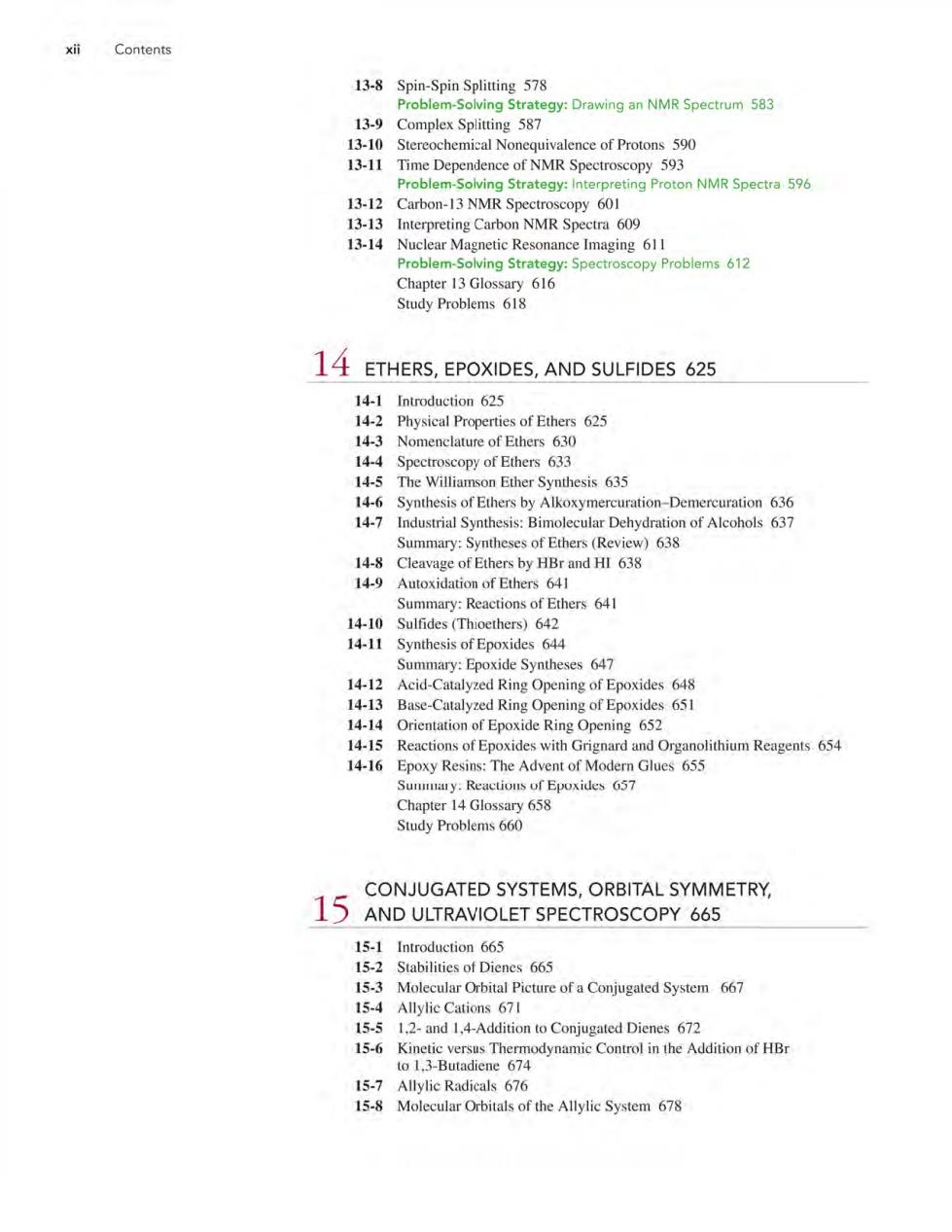正在加载图片...

x Contents 13-8 Spin-Spin Splitting 578 Problem-Solving Strategy:Drawing an NMR Spectrum 583 13-9 Complex Splitting 587 Stereochemical Nonequivalence of Protons590 13-11 n NMR Spectra 596 13.12 Carbon-13 NMR Sp 601 13.131 ting Carbon NMR Sp ctra 609 13-14 e Imaging 611 Problem-Solving Strategy:Spectroscopy Problems 612 Chapter 13 Glossary 616 Study Problems 618 14 ETHERS,EPOXIDES,AND SULFIDES 625 14-1 Introduction 625 14-2 Physical Properties of Ethers 625 14-3 Nomenclature of Ethers 630 144 Spectroscopy of Ethers 633 14-5 The Williamson Ether Synthesis 635 Synthesis of Ethers by Alkoxymercuration-Demercuration 636 14-7 Industrial Synthesis:Bimolecular Dehydration of Alcohols 637 Summary:Syntheses of Ethers(Review)638 148 Cleavage of Ethers by HBr and HI 638 14- on of Ethers thers 641 1410 eonsorB 1411 ses 647 1413 ed Ring 14-13 Base-Catalyzed Ring ening of Epoxides64 of Epoxides 651 14-14 Orientation of Epoxide Ring Opening 652 14.15 reactions of epoxides with grignard and orea olithium Reagents 654 14.16 Epoxy Resins:The Advent of Modern Glues 655 Sunmmry:Reactions of Epuxides 657 Chapter 14 Glossary 658 Study Problems 660 CoNJUGATED SYSTEMS ORBITAL SYMMETRY 15 AND ULTRAVIOLET SPECTROSCOPY 665 15-1 Introduction 665 of Dienes 665 15-3 Molecular Orbital Picture of a Conjugated System 667 15-4 Allylic Cations 671 15-5 1.2-and 1.4-Addition to Conjugated Dienes 672 15-6 Kinetic versus Thermodynamic Control in the Addition of HBr 1.3-Butadiene 674 Allylic Radical 670 ecular Orbitals of the Allylic System 678 xii Contents 13-8 Spin-Spin Splitting 578 Problem-Solving Strategy: Drawing an NMR Spectrum 583 13-9 Complex Splitting 587 13-10 Stereochemical Nonequivalence of Protons 590 13-11 Time Dependence of NMR Spectroscopy 593 Problem-Solving Strategy: Interpreting Proton NMR Spectra 596 13-12 Carbon-13 NMR Spectroscopy 601 13-13 Interpreting Carbon NMR Spectra 609 13-14 Nuclear Magnetic Resonance Imaging 611 Problem-Solving Strategy: Spectroscopy Problems 612 Chapter 13 Glossary 616 Study Problems 618 14 ETHERS, EPOXIDES, AND SULFIDES 625 14-1 Introduction 625 14-2 Physical Properties of Ethers 625 14-3 Nomenclature of Ethers 630 14-4 Spectroscopy of Ethers 633 14-5 The Williamson Ether Synthesis 635 14-6 Synthesis of Ethers by Alkoxymercuration-Demercuration 636 14-7 Industrial Synthesis: Bimolecular Dehydration of Alcohols 637 Summary: Syntheses of Ethers (Review) 638 14-8 Cleavage of Ethers by HBr and HI 638 14-9 Autoxidation of Ethers 641 Summary: Reactions of Ethers 641 14-10 Sulfides (Thioethers) 642 14-11 Synthesis of Epoxides 644 Summary: Epoxide Syntheses 647 14-12 Acid-Catalyzed Ring Opening of Epoxides 648 14-13 Base-Catalyzed Ring Opening of Epoxides 651 14-14 Orientation of Epoxide Ring Opening 652 14-15 Reactions of Epoxides with Grignard and Organolithium Reagents 654 14-16 Epoxy Resins: The Advent of Modern Glues 655 Summary: Reactions of Epoxides 657 Chapter 14 Glossary 658 Study Problems 660 5 CONJUGATED SYSTEMS, ORBITAL SYMMETRY, 1 AND ULTRAVIOLET SPECTROSCOPY 665 15-1 Introduction 665 15-2 Stabilities of Dienes 665 15-3 Molecular Orbital Picture of a Conjugated System 667 15-4 Allylic Cations 671 15-5 1,2- and 1,4-Addition to Conjugated Dienes 672 15-6 Kinetic versus Thermodynamic Control in the Addition of HBr to 1,3-Butadiene 674 15-7 Allylic Radicals 676 15-8 Molecular Orbitals of the Allylic System 678